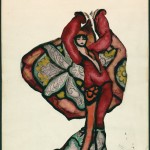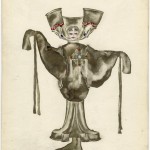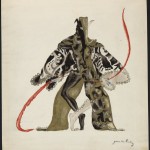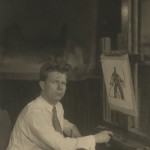Perhaps best known as the innovative designer of the Futurama exhibition in the General Motors pavilion at the 1939–1940 New York World’s Fair, Norman Bel Geddes was also a noted theater designer, fabricating costumes, sets, lighting, and theaters.
After beginning his career in Los Angeles, Bel Geddes moved to New York City in 1917 where his creative ambitions manifested in producing dynamic theater experiences. Using principles of the European New Stagecraft movement, Bel Geddes brought German director Max Reinhardt’s The Miracle to the American stage. The New Stagecraft movement, which divorced theater from the structures of bourgeois realism, aligned with Bel Geddes’s vision of simplified details and abstract settings and costumes.
Bel Geddes’s work on the 1924 production of The Miracle reveals his talents as a theatrical polymath. The play, a medieval legend about a nun, relied on Bel Geddes’s mechanized scenery and single switchboard. The technical modifications allowed a single electrician to control the focus, direction, and color of the lighting. Audience members sat on pews to watch the play, as Bel Geddes transformed the interior of the theater into a Gothic cathedral, complete with light trickling through stained glass windows and incense wafting through the air. The Miracle fused theater and architecture, creating a participatory environment that immersed audience members in the drama that surrounded them.
Highlighted here is a series of four costume designs for The Miracle, including “Oriental Gentleman,” “Chief Gypsy or Jester,” “Noble Gentleman,” and “Gypsy Woman.” The watercolors showcase Bel Geddes’s dexterity as an artist.
The innovations of Bel Geddes’s early theatrical career inform his later work as an industrial designer. Indeed, the same mechanical track system used to move scenery in The Miracle also guided model cars along the highway system of Futurama.
Materials from The Miracle and other theatrical works by Bel Geddes are on view in the exhibition I Have Seen the Future: Norman Bel Geddes Designs America, which runs through January 6, 2013.
Please click on the thumbnails to view larger images.





